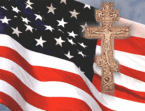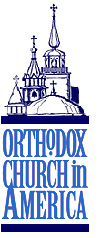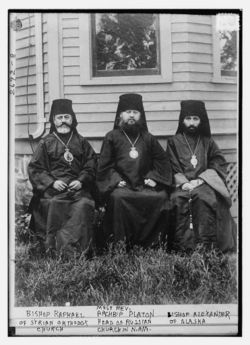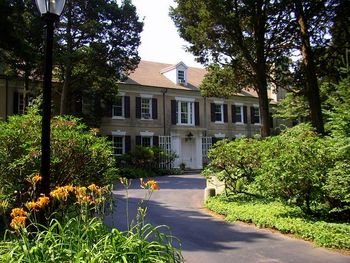Difference between revisions of "Orthodox Church in America"
(→Diocesan bishops: elevation) |
|||
| Line 103: | Line 103: | ||
* Right Reverend [[Nikon (Liolin) of Boston|Nikon (Liolin)]], Bishop of Boston, New England and the [[Albanian Archdiocese (OCA)|Albanian Archdiocese]] | * Right Reverend [[Nikon (Liolin) of Boston|Nikon (Liolin)]], Bishop of Boston, New England and the [[Albanian Archdiocese (OCA)|Albanian Archdiocese]] | ||
* Right Reverend [[Tikhon (Mollard) of Philadelphia|Tikhon (Mollard)]], Bishop of Philadelphia and [[Diocese of Eastern Pennsylvania (OCA)|Eastern Pennsylvania]] | * Right Reverend [[Tikhon (Mollard) of Philadelphia|Tikhon (Mollard)]], Bishop of Philadelphia and [[Diocese of Eastern Pennsylvania (OCA)|Eastern Pennsylvania]] | ||
| + | * Right Reverend [[Benjamin (Peterson) of San Francisco|Benjamin (Peterson)]], Bishop of San Francisco and the [[Diocese of the West (OCA)|Diocese of the West]] | ||
===Auxiliary bishops=== | ===Auxiliary bishops=== | ||
* Right Reverend [[Irineu (Duvlea) of Dearborn Heights|Irineu (Duvlea)]], Bishop of Dearborn Heights and auxiliary to Archbishop [[Nathaniel (Popp) of Detroit]] | * Right Reverend [[Irineu (Duvlea) of Dearborn Heights|Irineu (Duvlea)]], Bishop of Dearborn Heights and auxiliary to Archbishop [[Nathaniel (Popp) of Detroit]] | ||
| − | |||
* Right Reverend [[Alejo (Pacheco Vera) of Mexico City|Alejo (Pacheco Vera)]], Bishop of Mexico City and auxiliary to Metropolitan [[Herman (Swaiko) of Washington and New York]] | * Right Reverend [[Alejo (Pacheco Vera) of Mexico City|Alejo (Pacheco Vera)]], Bishop of Mexico City and auxiliary to Metropolitan [[Herman (Swaiko) of Washington and New York]] | ||
Revision as of 22:09, March 30, 2007
The Orthodox Church in America (OCA) is an autocephalous church with parishes mainly in the United States and Canada (though it has some parishes in Australia and elsewhere). The OCA was formerly known as the Russian Orthodox Greek Catholic Church in America, or more informally, the Metropolia. Previous to that, it was the North American Diocese of the Church of Russia. The OCA's autocephaly is not currently recognized by some of the other autocephalous Orthodox churches.
The current primate of the OCA is His Beatitude Herman (Swaiko), Archbishop of Washington and New York, and Metropolitan of All America and Canada.
| Orthodox Church in America | |
| Founder(s) | Ss. Herman of Alaska, Innocent of Alaska, Alexis of Wilkes-Barre |
| Autocephaly/Autonomy declared | 1970 ("temporary self-government" in 1924) |
| Autocephaly/Autonomy recognized | 1970 by Church of Russia |
| Current primate | Metropolitan Herman |
| Headquarters | Syosset, New York |
| Primary territory | United States and Canada |
| Possessions abroad | Mexico, South America, Australia |
| Liturgical language(s) | English, Church Slavonic, Spanish |
| Musical tradition | Russian Chant, Byzantine Chant (in some ethnic dioceses) |
| Calendar | Revised Julian, Julian |
| Population estimate | 30,000 to 1,000,000 |
| Official website | Orthodox Church in America |
Contents
[hide]History
Main Article: History of the OCA
The OCA began with the missionary work of the Russian Orthodox Church in Alaska and the Aleutian Islands by eight Orthodox monks who arrived in Alaska in 1794. They were part of the centuries-old missionary heritage of the Russian Orthodox Church that brought the Orthodox Church, by the monks Hourg and Barsanuphii, to the Mongol peoples. And monk St Stephen of Perm (1340-96) who would in turn journey beyond Kazan, across the Ural mountain, into the forests of Siberia to bring Orthodoxy to the pagan Zyrians. And the Russian monks who brought the Church even more eastward, eventually establishing a network of missions across Siberia and along the entire Pacific Rim: in China (1686), Alaska (1794), Japan (1861), and Korea (1898).
While the Church in Alaska was growing, immigrants were arriving in the rest of North America. In the 1860s a parish was established in San Francisco by Serbians, Russians and Greeks. Parishes were also established across the territory of the United States. At the end of the 19th century and the beginning of the 20th century, the headquarters of the North American Diocese was moved to San Francisco and then to New York. At this time there were great waves of Orthodox immigrants from Central, Eastern, and Southern Europe, and the Middle East. But, regardless of ethnic background, they were all united in a single diocese, or jurisdiction, which was under the Russian Orthodox Church.
In 1917, the Bolshevik Revolution brought communication between the churches in North America and Russia to an almost complete halt. In the early 1920s, Patriarch Tikhon of Moscow directed all Russian Orthodox churches outside of Russia to govern themselves autonomously until regular communication could be resumed. (He died in 1925, and was glorified as a saint by the Russian Orthodox Church in 1989.) Shortly thereafter, at a Council of all hierarchs and clergy and parish delegates, it was decided that the Church in North America could no longer maintain strict administrative ties with the Church in Russia, especially since Patriarch Tikhon had been arrested. Additionally, the loss of financial support from the fallen empire added to the diocese's problems.
At that time, some parishes which had been part of a single, multi-ethnic, North American diocese organized separate dioceses and placed themselves under various other mother churches, solidifying the current situation of multiple, ethnically-based, overlapping, jurisdictions in North America. Though the revolution in Russia helped to speed this fragmentation process along, it had already been occurring prior to 1917, as hundreds of Orthodox parishes in the US had been founded without any reference to the Russian presence, whose authority was not universally acknowledged.
From that point until the restoration of relations with Moscow in the 1960s, the Metropolia entered twice into union with the Russian Orthodox Church Outside Russia (see ROCOR and OCA), finally breaking with the latter body in 1946. Additionally, in 1927, the bishops of the Metropolia attempted to create an autocephalous body known as the American Orthodox Catholic Church, which failed after only six years.
In the early 1960s, the Metropolia (as it was then known) resumed communication with the Patriarch of Moscow, and in 1970 full communion was restored. At that time, the Patriarch of Moscow officially granted the OCA autocephaly, or self-governing administrative status. The OCA's autocephaly is not currently recognized by all autocephalous Orthodox Churches, including the Church of Constantinople. Churches that do recognize its autocephaly are mainly those in former Communist lands (most of which had thus come under the influence of the Church of Russia), including the Church of Russia, the Church of Bulgaria, the Church of Poland, the Church of Georgia, and the Church of the Czech Lands and Slovakia. According to apologists for OCA autocephaly, it is common for recognition of autocephaly to be granted belatedly; however opponents regard the grant as not being within the purview of Moscow's prerogatives (see Byzantine response to OCA autocephaly).
List of primates and ruling bishops
- Bishop Joasaph (Bolotov) Bishop of Kodiak Auxiliary of the Irkutsk Diocese (1799)
- Bishop Innocent (Veniaminov) of Alaska
- Bishop of Kamchatka, the Kurile and Aleutian Islands (1840-50)
- Archbishop of Kamchatka, the Kurile and Aleutian Islands (1850-68)
- Bishop Peter (Ekaterinovsky) Bishop of Novoarkhangelsk (Sitka) Auxiliary of the Kamchatka Diocese (1859-66)
- Bishop Paul (Popov) Bishop of Novoarkhangelsk (Sitka), Auxiliary of the Kamchatka Diocese (1866-70)
- Bishop John (Mitropolsky) Bishop of the Aleutians and Alaska (1870-77)
- Bishop Nestor (Zakkis) Bishop of the Aleutians and Alaska (1878-82)
- Bishop Vladimir (Sokolovsky-Avtonomov) Bishop of the Aleutians and Alaska (1887-91)
- Bishop Nicholas (Adoratsky) Bishop of the Aleutians and Alaska (1891)
- Bishop Nicholas (Ziorov) Bishop of the Aleutians and Alaska (1891-98)
- Bishop Tikhon (Belavin) of Moscow
- Bishop of the Aleutians and Alaska (1898-1900)
- Bishop of the Aleutians and North America (1900-05)
- Archbishop of the Aleutians and North America (1905-07)
- Archbishop Platon (Rozhdestvensky) Archbishop of the Aleutians and North America (1907-14)
- Archbishop Evdokim (Meschersky) Archbishop of the Aleutians and North America (1914-18)
- Archbishop Alexander (Nemolovsky) Archbishop of the Aleutians and North America (1919-22)
- Metropolitan Platon (Rozhdestvensky) Metropolitan of All America and Canada (1922-34)
- Metropolitan Theophilus (Pashkovsky) Archbishop of San Francisco, Metropolitan of All America and Canada (1934-50)
- Metropolitan Leonty (Turkevich) Archbishop of New York, Metropolitan of All America and Canada (1950-65)
- Metropolitan Ireney (Bekish) Archbishop of New York, Metropolitan of All America and Canada (1965-77)
- Archbishop Sylvester (Haruns) Archbishop of Montreal and Canada, Temporary Administrator of the Orthodox Church in America (1974-77)
- Metropolitan Theodosius (Lazor)
- Archbishop of New York, Metropolitan of All America and Canada (1977-80)
- Archbishop of Washington, Metropolitan of All America and Canada (1981-2002)
- Metropolitan Herman (Swaiko)
- Archbishop of Washington, Metropolitan of All America and Canada (2002-2005)
- Archbishop of Washington and New York, Metropolitan of All America and Canada (2005-Present)
The OCA today
In the United States, there are 12 dioceses and 623 parishes, missions, and institutions (456 of which are parishes). The ethnic dioceses extend into Canada, which also has one non-ethnic archdiocese. Altogether there are 91 Canadian parishes. The OCA has a Mexican Exarchate with nine parishes and missions, and there are five parishes in South America. In addition, there are two parishes in Australia under the OCA's canonical protection, one in Queensland and one in New South Wales.
There are three ethnically defined dioceses in the OCA: the Albanian (14 parishes), Bulgarian (19 parishes) and Romanian (92 parishes). These dioceses' geographic territory overlaps with the other dioceses of the OCA and they have under their care parishes with those ethnic associations. These dioceses are the result of smaller ethnic jurisdictions joining the OCA at some point in its history, usually after having broken from other bodies.
The OCA also has 27 monastic communities, six of which fall under the direct jurisdiction of the Metropolitan (i.e., are stavropigial). The largest of these monasteries are New Skete (Cambridge, New York) and St. Tikhon's Orthodox Monastery (South Canaan, Pennsylvania).
There are three seminaries operated by the OCA: St. Tikhon's Orthodox Theological Seminary (founded 1937), St. Vladimir's Orthodox Theological Seminary (founded 1938), and St. Herman's Orthodox Theological Seminary (founded 1973). All three educate seminarians from multiple Orthodox jurisdictions, including those outside North America.
The OCA is a member of the Standing Conference of the Canonical Orthodox Bishops in the Americas (SCOBA).
Since November of 2005, when a list of accusations were brought forward by Protodeacon Eric Wheeler, the former treasurer of the OCA, its administration has been the subject of allegations of financial misconduct. Internal investigations, audits, and other actions have since then been enacted in an attempt to address the allegations, including the firing of the OCA chancellor, Protopresbyter Robert S. Kondratick. The OCA News website, a privately operated site with no connection to the administration, has been publishing reports and editorials on the scandal since January of 2006, including allegations of division within the OCA's holy synod.
Growth and membership figures
Altogether, estimates of OCA faithful number from about 28,000[1] to 1 million[2] to 2 million[3], depending on the report cited and method used for counting. The number of new parishes founded from 1990 to 2000 increased the overall parish number by about 12%, and new membership has been fairly equally divided between new immigrants, children of existing members, and converts to the faith. Overall, according to one report the trend during that decade held the population of OCA faithful in neither increase nor decline, but remaining steady.[4] According to another, however, that same decade saw a 13% decline.[5]
| This article forms part of the series Orthodoxy in America | |

| |
| History | |
| American Orthodox Timeline American Orthodox Bibliography Byzantines on OCA autocephaly Ligonier Meeting ROCOR and OCA | |
| People | |
| Saints - Bishops - Writers | |
| Jurisdictions | |
| Antiochian - Bulgarian OCA - Romanian - Moscow ROCOR - Serbian Ecumenical Patriarchate: | |
| Monasteries | |
| Seminaries | |
| Christ the Saviour Holy Cross Holy Trinity St. Herman's |
St. Tikhon's St. Sava's St. Sophia's St. Vladimir's |
| Organizations | |
| Assembly of Bishops AOI - EOCS - IOCC - OCEC OCF - OCL - OCMC - OCPM - OCLife OISM - OTSA - SCOBA - SOCHA | |
| Groups | |
| Amer. Orthodox Catholic Church Brotherhood of St. Moses the Black Evangelical Orthodox Church Holy Order of MANS/CSB Society of Clerks Secular of St. Basil | |
| Edit this box | |
According to Fr. Jonathan Ivanoff, who is on the administrative committee of the OCA's Department of Evangelization and the board of directors of the Orthodox Christian Mission Center, the OCA's American contintental membership (i.e., not including Alaska, Canada, or the ethnic dioceses) "has been declining between 6 and 9% for nearly 20 years. The OCA's Census population in 1994 was 29,775; in 2004 it stood at 27,169."[6] Despite these sobering figures, however, the OCA's dioceses of the West and South, as well as many parishes in other dioceses, have reported steady growth.
Name
According to Bishop Tikhon (Fitzgerald) of San Francisco and Los Angeles, the name of this jurisdiction is The Orthodox Church in America, and its acronym should be TOCA.[7] There has not yet been any official announcement from the central administration of the church, however, and the former uses (Orthodox Church in America and OCA) remain the most common both within and outside the jurisdiction.
According to the 1970 Tomos of Autocephaly granted by the Church of Russia, the name of this church body was originally The Autocephalous Orthodox Church in America.[8] According to the Statute of the Orthodox Church in America, adopted by the Second All-American Council in October 1971, the usage is The Orthodox Church in America at the beginning of sentences[9] and the Orthodox Church in America in the middle of sentences[10], thus seeming to imply that the capitalization of the in the name is not vital.
Episcopacy
Diocesan bishops
- Most Blessed Herman (Swaiko), Archbishop of Washington and New York, Metropolitan of All America and Canada, locum tenens of the Diocese of the West
- Most Reverend Kyrill (Yonchev), Archbishop of Pittsburgh and Western Pennsylvania and the Bulgarian Diocese
- Most Reverend Dmitri (Royster), Archbishop of Dallas and the South, Exarch of Mexico
- Most Reverend Nathaniel (Popp), Archbishop of Detroit and the Romanian Episcopate
- Most Reverend Job (Osacky), Archbishop of Chicago and the Midwest
- Most Reverend Seraphim (Storheim), Archbishop of Ottawa and Canada
- Right Reverend Nikolai (Soraich), Bishop of Sitka, Anchorage and Alaska
- Right Reverend Nikon (Liolin), Bishop of Boston, New England and the Albanian Archdiocese
- Right Reverend Tikhon (Mollard), Bishop of Philadelphia and Eastern Pennsylvania
- Right Reverend Benjamin (Peterson), Bishop of San Francisco and the Diocese of the West
Auxiliary bishops
- Right Reverend Irineu (Duvlea), Bishop of Dearborn Heights and auxiliary to Archbishop Nathaniel (Popp) of Detroit
- Right Reverend Alejo (Pacheco Vera), Bishop of Mexico City and auxiliary to Metropolitan Herman (Swaiko) of Washington and New York
Retired bishops
- Most Blessed Theodosius (Lazor), Archbishop of Washington, Metropolitan of All America and Canada
- Most Reverend Peter (L'Huillier), Archbishop of New York and New Jersey
- Most Reverend Gregory (Afonsky), Archbishop of Sitka and Alaska
- Right Reverend Mark (Forsberg), Bishop of Boston
- Most Reverend Lazar (Puhalo), Archbishop of Ottawa
- Right Reverend Tikhon (Fitzgerald), Bishop of San Francisco, Los Angeles and the West
- Right Reverend Varlaam (Novakshonoff), Bishop of Vancouver
See also
| Autocephalous and Autonomous Churches of Orthodoxy |
| Autocephalous Churches |
| Four Ancient Patriarchates: Constantinople · Alexandria · Antioch · Jerusalem Russia · Serbia · Romania · Bulgaria · Georgia · Cyprus · Greece · Poland · Albania · Czech Lands and Slovakia · OCA* · Ukraine* |
| Autonomous Churches |
| Sinai · Finland · Estonia* · Japan* · China* · Ukraine* |
| The * designates a church whose autocephaly or autonomy is not universally recognized. |
External links
- Official Website of the OCA
- The Road to Autocephaly 1963-1970 Talk given by Dr. Constantine H. Kallaur
- The Tomos of Autocephaly Signed in the city of Moscow, April 10, 1970, by the Patriarch of Moscow and All Russia and the members its Holy Synod.
- The Statute of the Orthodox Church in America
- Eastern Christian Churches: OCA by Ronald Roberson, a Roman Catholic priest and scholar
- OCANews.org: Orthodox Christians for Accountability, a website critical of the OCA's administration
- OCAchallenges.org, a forum for discussing improvements in the OCA


